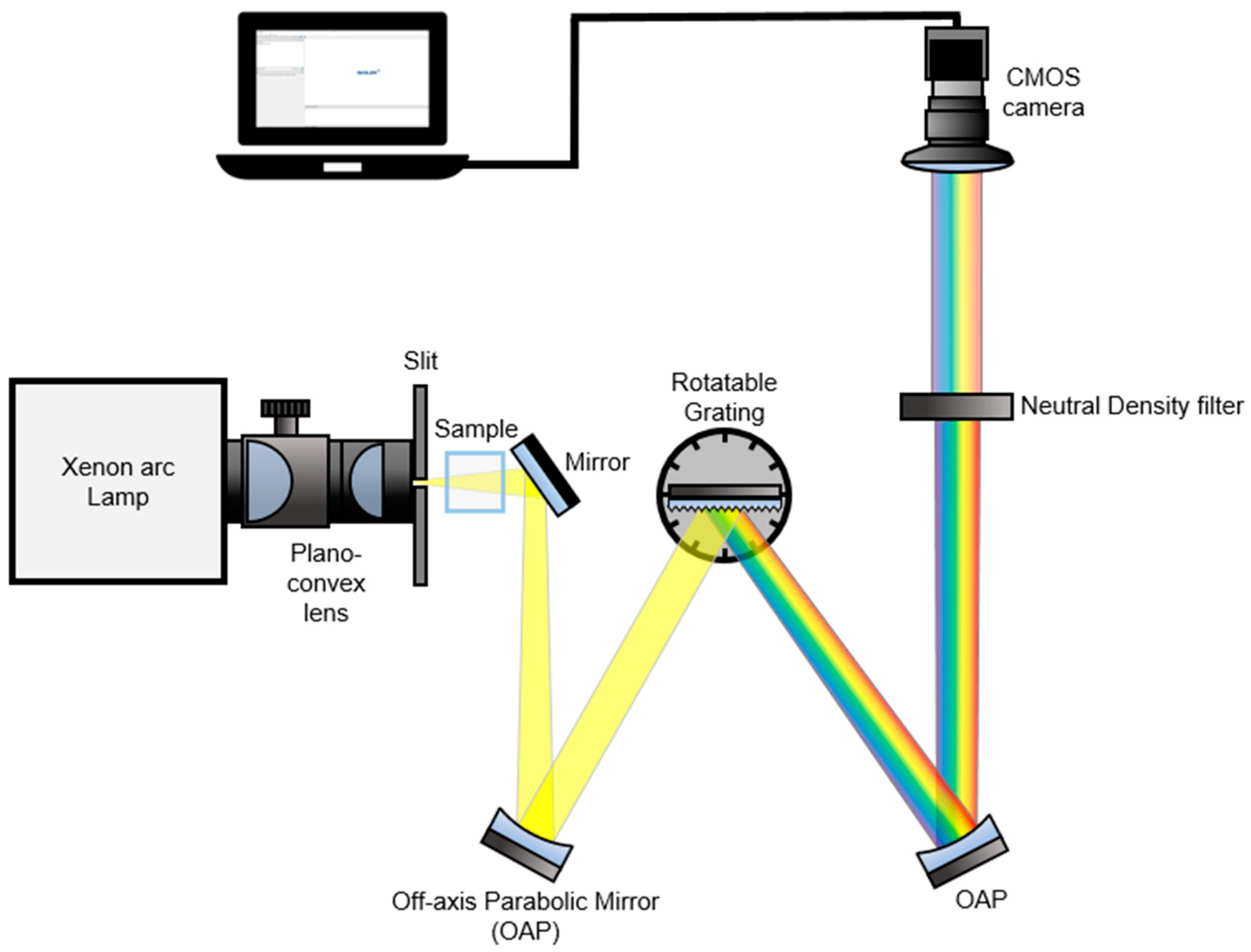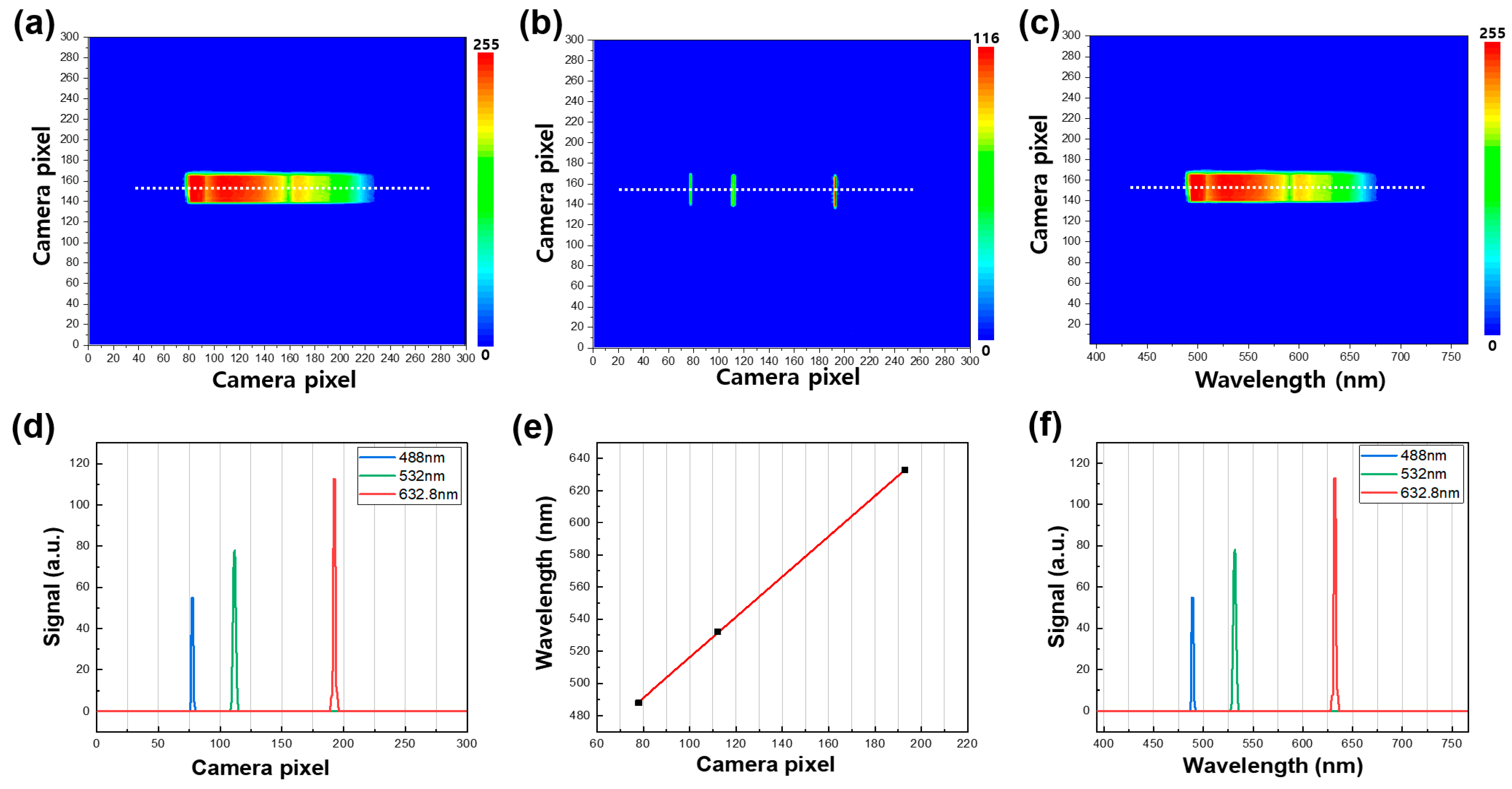Real-Time UV/VIS Spectroscopy to Observe Photocatalytic Degradation
Abstract
1. Introduction
2. Results
2.1. Optical Setup
2.2. Wavelength Calibration
2.3. Real-Time Sample Detection
3. Materials and Methods
3.1. UV/VIS Spectroscopy
3.2. Xenon Arc Lamp Light Source
3.3. Sample Preparation
3.4. TiO2 Photocatalysis
3.5. CMOS Camera
4. Conclusions
Author Contributions
Funding
Data Availability Statement
Conflicts of Interest
References
- Waterhouse, G.I.; Waterland, M.R. Opal and inverse opal photonic crystals: Fabrication and characterization. Polyhedron 2007, 26, 356–368. [Google Scholar] [CrossRef]
- Ferraris, M.; Milanese, D.; Contardi, C.; Chen, Q.; Menke, Y. UV–Vis, FT-IR and EPR investigation on multi-component germano-silicate glasses for photonics. J. Non-Cryst. Solids 2004, 347, 246–253. [Google Scholar] [CrossRef]
- Wang, J.; Burdzinski, G.; Kubicki, J.; Platz, M.S. Ultrafast UV−Vis and IR Studies of p-Biphenylyl Acetyl and Carbomethoxy Carbenes. J. Am. Chem. Soc. 2008, 130, 11195–11209. [Google Scholar] [CrossRef]
- Kazarian, S.; Chan, K. Applications of ATR-FTIR spectroscopic imaging to biomedical samples. Biochim. Biophys. Acta (BBA)-Biomembr. 2006, 1758, 858–867. [Google Scholar] [CrossRef] [PubMed]
- Kennis, J.T.; Groot, M.-L. Ultrafast spectroscopy of biological photoreceptors. Curr. Opin. Struct. Biol. 2007, 17, 623–630. [Google Scholar] [CrossRef]
- Grupe, M.; Bäppler, F.; Theiß, M.; Busch, J.M.; Dietrich, F.; Volz, D.; Gerhards, M.; Bräse, S.; Diller, R. Real-time observation of molecular flattening and intersystem crossing in [(DPEPhos) Cu (i)(PyrTet)] via ultrafast UV/Vis-and mid-IR spectroscopy on solution and solid samples. Phys. Chem. Chem. Phys. 2020, 22, 14187–14200. [Google Scholar] [CrossRef]
- Yoon, Y.; Breshike, C.J.; Kendziora, C.A.; Furstenberg, R.; McGill, R.A. Simultaneous real-time spectroscopy using a broadband IR laser source. Opt. Express 2021, 29, 8902–8913. [Google Scholar] [CrossRef]
- Karabacak, M.; Cinar, M.; Unal, Z.; Kurt, M. FT-IR, UV spectroscopic and DFT quantum chemical study on the molecular conformation, vibrational and electronic transitions of 2-aminoterephthalic acid. J. Mol. Struct. 2010, 982, 22–27. [Google Scholar] [CrossRef]
- Serezhkina, S.V.; Tyavlovskaya, E.A.; Shevchenko, G.P.; Rakhmanov, S.K. Investigation of structural and compositional changes in silver-doped GeO2 thin films. J. Non-Cryst. Solids 2005, 351, 35–40. [Google Scholar] [CrossRef]
- Herrmann, J.-M. Photocatalysis. In Kirk-Othmer Encyclopedia of Chemical Technology; John Wiley & Sons, Inc.: Hoboken, NJ, USA, 2017; pp. 1–44. [Google Scholar]
- Wen, M.; Li, G.; Liu, H.; Chen, J.; An, T.; Yamashita, H. Metal–organic framework-based nanomaterials for adsorption and photocatalytic degradation of gaseous pollutants: Recent progress and challenges. Environ. Sci. Nano 2019, 6, 1006–1025. [Google Scholar] [CrossRef]
- Robert, D.; Malato, S. Solar photocatalysis: A clean process for water detoxification. Sci. Total Environ. 2002, 291, 85–97. [Google Scholar] [CrossRef] [PubMed]
- Houas, A.; Lachheb, H.; Ksibi, M.; Elaloui, E.; Guillard, C.; Herrmann, J.-M. Photocatalytic degradation pathway of methylene blue in water. Appl. Catal. B Environ. 2001, 31, 145–157. [Google Scholar] [CrossRef]
- Kwon, C.H.; Shin, H.; Kim, J.H.; Choi, W.S.; Yoon, K.H. Degradation of methylene blue via photocatalysis of titanium dioxide. Mater. Chem. Phys. 2004, 86, 78–82. [Google Scholar] [CrossRef]
- Fan, H.; Zhao, X.; Yang, J.; Shan, X.; Yang, L.; Zhang, Y.; Li, X.; Gao, M. ZnO–graphene composite for photocatalytic degradation of methylene blue dye. Catal. Commun. 2012, 29, 29–34. [Google Scholar] [CrossRef]
- Tang, J.; Zou, Z.; Yin, J.; Ye, J. Photocatalytic degradation of methylene blue on CaIn2O4 under visible light irradiation. Chem. Phys. Lett. 2003, 382, 175–179. [Google Scholar] [CrossRef]
- Yang, X.; Chen, W.; Huang, J.; Zhou, Y.; Zhu, Y.; Li, C. Rapid degradation of methylene blue in a novel heterogeneous Fe3O4@ rGO@ TiO2-catalyzed photo-Fenton system. Sci. Rep. 2015, 5, 1–10. [Google Scholar] [CrossRef]
- Muniandy, L.; Adam, F.; Mohamed, A.R.; Ng, E.-P.; Rahman, N.R.A. Carbon modified anatase TiO2 for the rapid photo degradation of methylene blue: A comparative study. Surf. Interfaces 2016, 5, 19–29. [Google Scholar] [CrossRef]
- Singhal, G.; Rabinowitch, E. Changes in the absorption spectrum of methylene blue with pH. J. Phys. Chem. 1967, 71, 3347–3349. [Google Scholar] [CrossRef]
- Xu, X.; Lei, M.; Huang, K.; Liang, C.; Xu, J.; Shangguan, Z.; Yuan, Q.; Ma, L.; Du, Y.; Fan, D. A facile route to porous beta-gallium oxide nanowires-reduced graphene oxide hybrids with enhanced photocatalytic efficiency. J. Alloys Compd. 2015, 623, 24–28. [Google Scholar] [CrossRef]
- Yesilkoy, F.; Arvelo, E.R.; Jahani, Y.; Liu, M.; Tittl, A.; Cevher, V.; Kivshar, Y.; Altug, H. Ultrasensitive hyperspectral imaging and biodetection enabled by dielectric metasurfaces. Nat. Photonics 2019, 13, 390–396. [Google Scholar] [CrossRef]
- Lu, G.; Fei, B. Medical hyperspectral imaging: A review. J. Biomed. Opt. 2014, 19, 010901. [Google Scholar] [CrossRef] [PubMed]
- Shultz, A.; Campbell, D.; Messman, J. Reference material standardization guidelines for quality control and validation of UV/VIS absorption spectrophotometers. Cal Lab 1998, 27. [Google Scholar]
- Didymium Glass Reference for Wavelength in the Visible. Available online: https://www.starnacells.com/d_ref/d_wl/DG.html (accessed on 17 May 2022).
- Lakshmi, S.; Renganathan, R.; Fujita, S. Study on TiO2-mediated photocatalytic degradation of methylene blue. J. Photochem. Photobiol. A Chem. 1995, 88, 163–167. [Google Scholar] [CrossRef]
- Heger, D.; Jirkovsky, J.; Klan, P. Aggregation of methylene blue in frozen aqueous solutions studied by absorption spectroscopy. J. Phys. Chem. A 2005, 109, 6702–6709. [Google Scholar] [CrossRef]
- Libowitzky, E.; Rossman, G.R. Principles of quantitative absorbance measurements in anisotropic crystals. Phys. Chem. Miner. 1996, 23, 319–327. [Google Scholar] [CrossRef]
- Eckerle, K.; Chang, S.; Hsia, J. Calibration in 1976 and 1983 of didymium glass filters issued as NBS Standard Reference Materials. Color Res. Appl. 1985, 10, 32–37. [Google Scholar] [CrossRef]
- Azeez, F.; Al-Hetlani, E.; Arafa, M.; Abdelmonem, Y.; Nazeer, A.A.; Amin, M.O.; Madkour, M. The effect of surface charge on photocatalytic degradation of methylene blue dye using chargeable titania nanoparticles. Sci. Rep. 2018, 8, 1–9. [Google Scholar] [CrossRef] [PubMed]
- Umebayashi, T.; Yamaki, T.; Tanaka, S.; Asai, K. Visible light-induced degradation of methylene blue on S-doped TiO2. Chem. Lett. 2003, 32, 330–331. [Google Scholar] [CrossRef]
- Linsebigler, A.L.; Lu, G.; Yates, J.T., Jr. Photocatalysis on TiO2 surfaces: Principles, mechanisms, and selected results. Chem. Rev. 1995, 95, 735–758. [Google Scholar] [CrossRef]






| Sample | Ethanol (mL) | Methylene Blue (mg) | TiO2 Nanoparticle (mg) | TiO2 Nanoparticle (wt.%) |
|---|---|---|---|---|
| Sample A | 40 | 0.2 | 1 | 0.003 |
| Sample B | 40 | 0.2 | 2 | 0.006 |
| Sample C | 40 | 0.2 | 3 | 0.010 |
| Sample D | 40 | 0.2 | 4 | 0.013 |
Disclaimer/Publisher’s Note: The statements, opinions and data contained in all publications are solely those of the individual author(s) and contributor(s) and not of MDPI and/or the editor(s). MDPI and/or the editor(s) disclaim responsibility for any injury to people or property resulting from any ideas, methods, instructions or products referred to in the content. |
© 2023 by the authors. Licensee MDPI, Basel, Switzerland. This article is an open access article distributed under the terms and conditions of the Creative Commons Attribution (CC BY) license (https://creativecommons.org/licenses/by/4.0/).
Share and Cite
Woo, S.; Jung, H.; Yoon, Y. Real-Time UV/VIS Spectroscopy to Observe Photocatalytic Degradation. Catalysts 2023, 13, 683. https://doi.org/10.3390/catal13040683
Woo S, Jung H, Yoon Y. Real-Time UV/VIS Spectroscopy to Observe Photocatalytic Degradation. Catalysts. 2023; 13(4):683. https://doi.org/10.3390/catal13040683
Chicago/Turabian StyleWoo, Sanguk, Hyein Jung, and Yohan Yoon. 2023. "Real-Time UV/VIS Spectroscopy to Observe Photocatalytic Degradation" Catalysts 13, no. 4: 683. https://doi.org/10.3390/catal13040683
APA StyleWoo, S., Jung, H., & Yoon, Y. (2023). Real-Time UV/VIS Spectroscopy to Observe Photocatalytic Degradation. Catalysts, 13(4), 683. https://doi.org/10.3390/catal13040683






